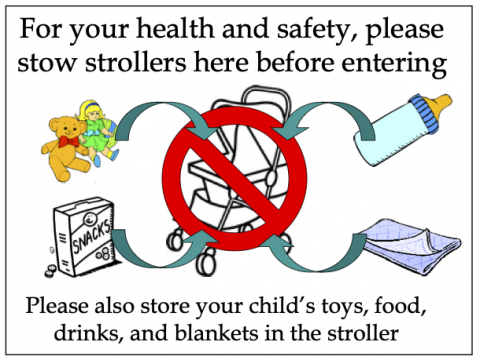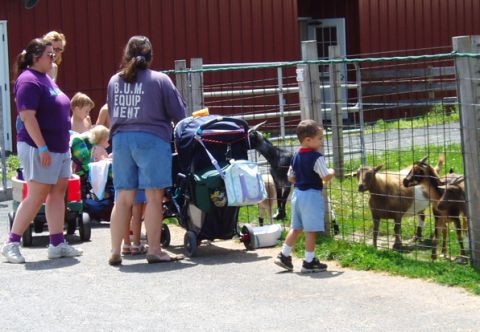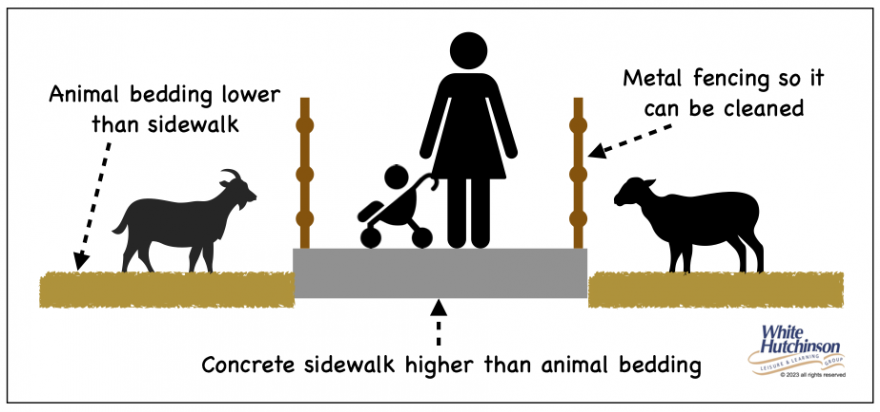
Vol. I, No. 2, April 2023
Can strollers be allowed in petting zoos; the E. coli O157 risk
Last month's issue included an extensive article, The E. Coli 0157 menace: Designing and operating safe animal petting areas. Transmission of dangerous E. coli 0157:H7 occurs in animal areas when people pet, touch, feed, or are licked by animals or have contacted contaminated animal bedding, flooring, barriers, or other contaminated surfaces, including strollers, clothes, and shoes.

Among the many recommendations in that article was that strollers should not be permitted in animal areas, and there should be a clearly marked designated area near the entrance for visitors to leave strollers and related items (e.g., wagons, diaper bags, toys, pacifiers, and baby bottles). One of the reasons to not allow strollers into the animal area is so the wheels won't carry E. coli 0157 picked up from the ground to outside the animal area and possibly home.
A 2-year-old's death in 2022 illustrates the risk of carrying E. coli 0157 home. The Tennessee Department of Health found the child's older brother attended summer camp at an agritourism farm where he picked up E. coli. 0157. The bacteria were then transmitted to the 2-year-old at home, who developed hemolytic uremic syndrome and died. The TDH also found that two other children who attended the summer camp got ill. The source of E. coli 0157 was traced to two baby goats that were in contact with the confirmed cases.
A South Carolina Department of Health and Environmental Control study watched 227 people in a petting zoo to see how they engaged in risky behaviors. The top three risky behaviors observed were bringing food into the area, bringing a stroller into the area, and picking stuff like pet food off the ground. So even with signage, not everyone will leave their stroller outside the animal area.
When an animal area is designed with one-way traffic to enter at one end and exit at the other end, this can make leaving a stroller at the entrance very inconvenient and discourage the practice.

We recently worked with one of our agritourism clients in Canada to design their new animal petting area, including a walk-thru animal barn. One of the farm family members, a woman with children, brought up how she didn't like the idea of not being able to take the stroller into the animal area since it was like her backpack with all the things she needs to take care of her child as well as it holds her child.
This got us thinking. Is there a solution for safely allowing strollers into a petting zoo? The answer would be to ensure the stroller wheels don't pick up any E. coli 0157 from the ground. This would also address the risk of people carrying E. coli 0157 out of the animal area on their shoes, which could have been how the child in Tennessee brought the E. coli home that contaminated and killed his 2-year-old brother. A study at two petting zoos where E. coli 0157 sickened 34 people found that stepping in or having manure on their shoes was strongly associated with the illness.
The solution wasn't that difficult to figure out. Raise the walking/stroller path above the animal bedding such that bedding materials and manure can't get on the path. This includes designing the path in any outdoor animal areas so it couldn't get contaminated by run-off from animal areas in a heavy rain. Ideally, the path would be concrete, a sidewalk, so it can also be hosed clean daily.

This would also solve the risk for people using wheelchairs or other mobility assistance devices who, under ADA, must be allowed to enter the animal area. Sanitizing the wheels after leaving the animal area would no longer be needed.
One problem with allowing strollers into the animal area with a safely designed and constructed sidewalk is it will enable the parents to bring along the toys, pacifiers, baby bottles, and other things that should not be brought out and used by the child. A study at 36 petting zoos in Ontario, Canada, found that the following items that would come into contact with the mouths of infants and children were carried into the petting zoos: baby bottles - 50%, pacifiers - 71%, spill-proofs cups - 56%, and infant toys - 65%. An answer to assuring these things aren't taken out of the strollers is to have a staff member monitoring people in the animal area.
One thing that could defeat having a contaminated-free sidewalk is if there's a petting area people go into to interact with and pet animals, which most petting areas have. This would allow contaminated materials to be brought out on their shoes and cross-contaminate the sidewalk. If such an area exists, strollers should not be allowed to enter, and the bedding materials need to be regularly replaced and keep free of animal poop.
There can also be transmission of E. coli 0157 by airborne particles and dust from dry manure and animal poop. It is crucial never to allow manure and poop to become dehydrated. Animal areas should be regularly cleared to make sure this can't occur.
The above is not a risk-free solution for allowing strollers into animal petting areas. The ideal lowest-risk solution is still not to allow them in.* To assure this happens would require, in addition to signage, having a staff member at the entrance to stop anyone attempting to bring strollers in.
Regardless of whether strollers are allowed in, having raised sidewalks definitely reduces the risk of E. coli 0157 infections for visitors to animal petting areas.
* The potential consequences of young children getting an E. coli 0157 infection are so serious that the U.S. Centers for Disease Control and Prevention recommends that parents refrain from taking strollers, bottles, pacifiers, sippy cups, or toys into animal areas.
Subscribe to Agritourism Today



